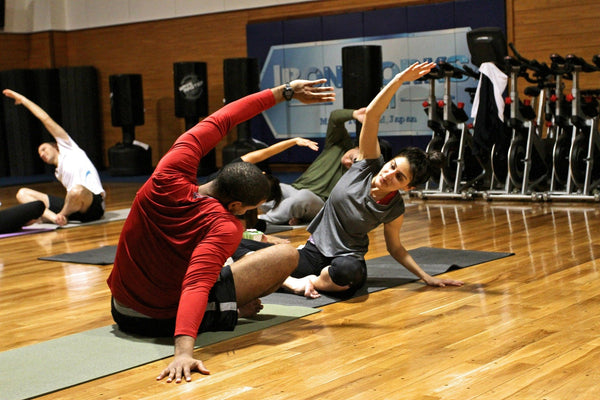16 Mucus Clearing Techniques That Alleviate Shortness of Breath

Many people with respiratory diseases COPD and Cystic Fibrosis have to deal with extra phlegm and congestion in their lungs and airways. It's an unfortunate symptom that can be difficult to manage, especially during periods of illness and exacerbations.
The reason for the excess mucus is inflammation in the respiratory tract caused by the disease. This kicks your mucus membranes into overdrive in an attempt to lubricate and soothe the lungs and airways, but it often leads to way too much extra mucus that is difficult to clear out.
Another cause of congestion in people with COPD is damaged lung tissue, which is not nearly as good at moving mucus up and out of your chest as healthy lungs are. When you pair that with decreased lung function and restricted airways, it can be nearly impossible to force out phlegm without some extra help.
For someone with COPD, excess mucus is particularly difficult to deal with because of common symptoms like chest tightness and airway restriction. When there's extra mucus and phlegm hanging around in the respiratory tract, it is especially difficult and uncomfortable for someone with COPD to breathe and cough controllably.
Fortunately, there are many different techniques and medications that can clear up congestion for people with a respiratory disease. That's why in this article we are going to teach you 16 effective methods respiratory patients can use to loosen and expel excess mucus.
It's important to note that if you suffer from any respiratory disease, not just COPD, and have trouble dealing with mucus, these tips will work for you.
{{cta('b59df0c1-c4de-47a8-8e1c-0d33d4b414aa','justifycenter')}}
Physical Techniques to Help Clear Mucus for COPD
1. Controlled Deep Coughing

Coughing is the body's natural, instinctual way to get rid of chest congestion, and it's often surprisingly effective. When your COPD causes your airways to get clogged up with mucus, coughing is one of the first things you should try.
However, uncontrolled, frantic coughing is usually not the best way to clear mucus from your airways. That's why doctors have developed coughing techniques to help you control your coughing and make it even more effective, especially for COPD patients who have difficulty producing strong, productive coughs.
A “controlled deep cough” is a simple, heavy cough that you force from deep in your lungs. Start by sitting in a comfortable place, leaning forward slightly, taking a long, deep breath in.
Next, hold your breath for just a few seconds and then use your abdominal muscles to forcefully push the air out through your mouth. You can even cross your arms over your stomach and use gentle pressure on your abdomen to help expel the breath.
While practicing this technique, you might get the urge to clear your throat or begin coughing reflexively, but do your best to ignore the impulse. Instead, take a few normal breaths, and then try another deep, controlled cough.
This method is more comfortable, and more effective, than a hacking, uncontrolled cough.
2. Controlled Huff Coughing
Another form of controlled coughing, huff coughing, is a gentle and effective way to clear phlegm out of your airways. It's also known as the forced expiration technique and it works because it keeps the throat open and effectively moves mucus out of the lungs.
There are 5 simple steps to performing a huff cough:
-
Start by sitting upright in a comfortable seat and lift your chin slightly.
-
Empty your lungs by exhaling slowly and completely for several seconds.
-
Next, take a slow, deep breath in, using your diaphragm (belly breaths).
-
Hold your breath for 2-3 seconds, then force the air out through your mouth in three rapid huffs, taking care to keep your throat open
- Repeat the technique, but take a slightly smaller breath this time. You can repeat the huff coughing technique as needed, alternating between small and large breaths.
Successful huff coughing usually requires about 3-5 repetitions with at least 5-10 normal breaths in between. A respiratory therapist or doctor can help you perfect the proper huffing technique, and remember to stop huffing if you begin to feel pain or exhaustion.
{{cta('fa8abc2a-1e88-4fa3-82fd-1cb5b9ed43b2','justifycenter')}}
3. Chest Percussions

Chest percussion is a type of chest physical therapy that essentially involves tapping or clapping on your chest with your hand. This physically loosens and breaks down mucus that is stuck in your airways, making it easier to cough up out of your lungs.
The proper technique is to sit while leaning back and use a cupped hand to deliver very firm, but gentle claps to the upper-left and upper-right part of your chest (in the space between your collarbone and nipple). You will want to start by tapping the left side of your chest for 2-3 minutes, and then repeat the percussions on the right side for another 2-3 minutes.
You should feel the mucus loosening in your chest as you perform the percussions and feel the urge to cough immediately after. Allow yourself to cough up as much mucus as you can in-between percussions until you've cleared all the excess phlegm from your chest.
Percussions should always be firm, but not painful, and done in a steady rhythm. Always make sure to position your hands in the correct place before performing any kind of percussion.
Do NOT perform percussions on any of these areas:
- Avoid the stomach
- Avoid the breastbone
- Avoid the spine
- Avoid the lower ribs and lower back (to prevent injuring organs)
4. Back Percussions

Back percussions usually require you to have a caregiver or respiratory therapist there to help out. They are very similar to chest percussions, but you lean forward and have someone else tap key spots on your back instead of your chest.
Start in a leaning-forward position, by holding a pillow to your chest and bending forward at the waist. Then have your therapist or caregiver tap gently but firmly on your back with a cupped hand, in the space right above your shoulder blade.
Tap for 2-3 minutes in that spot, then repeat again above your right shoulder blade. The mucus in your chest should loosen, allowing you to cough and expel it from your lungs.
5. Vibration

Vibration is another form of chest physiotherapy that is often done in combination with chest and back percussions. You can perform vibration therapy on the same areas that you do percussions on: both sides of the upper chest and back.
To do manual vibrations, simply place both hands, flat and palm-side down, on the target area. Then, using gentle pressure with the heels of both hands, tense your hands and wrists and shake them in a vibration-like motion. The patient should exhale slowly as you perform the vibration.
COPD patients will most likely need a caregiver or respiratory therapist to help perform vibrations, but there is special equipment available that allows patients do it on their own. There's an inflatable vest called a high-frequency chest wall oscillator that uses air pressure to deliver high frequency vibrations to the chest and back.
You usually use a high-frequency chest wall oscillator for about five minutes at a time with breaks to allow you to cough and clear out the loosened mucus between sessions. Chest wall oscillator devices are surprisingly non-bulky and streamlined, and there are several different versions on the market, including the Vest Airway Clearance System and the SmartVest.
6. Positioning to Promote Drainage

Another form of chest physiotherapy, postural drainage, is about placing your body in different poses or positions to help mucus drain downward out of your lungs. The unique positions encourage different lobes, or sections, of your lung to drain out until you can cough up or spit out the phlegm.
Positional drainage is often much more effective when you use it in combination with chest percussions and vibrations. It works best if a caregiver or respiratory therapist helps by performing the vibrations while the patient relaxes in a postural drainage position and exhales slowly.
Here are a couple of common postural drainage positions (although there are still many others!):
-
Draining mucus from the back of the lungs: In this position, you lie on your stomach and place pillows under your hips (usually three pillows are recommended) to raise your lower back and a small pillow under your head for comfort. Place your arms above your head and breathe deep from your belly.
- Draining mucus from the sides of your lungs: To drain the sides of your lungs, lie on one side and place a few pillows under your hip and a small pillow under your head. Stay in this position for 5 or 10 minutes, breathing deep from your belly for the duration.
The gravity along with the percussions and vibrations should effectively move the mucus out of your lungs, into your larger airways, and to your mouth where you can expel the excess sputum.
{{cta('43b79c5e-6bd6-4f02-ac27-2d038d20c146','justifycenter')}}
A Last Word on Chest Physiotherapy
Most chest physical therapy sessions last somewhere between 20-40 minutes, and include alternating a variety of techniques including positional drainage, vibration, percussion, deep coughing, and huff coughing. You can do multiple sessions per day if needed, in fact doctors usually encourage COPD patients with excess mucus to do chest physiotherapy once in the morning and once before bed.
As you should before starting any kind of new therapy, make sure you talk to your doctor before starting or changing your chest physiotherapy regimen. Your doctor will be able to give you the best advice for how, when, and how often you should do it.
7. Active Cycle of Breathing Technique (ACBT)

The Active Cycle of Breathing Technique, or ACBT, is a three-step method for clearing mucus from your airways that is often recommended to patients with COPD. Like some of the other techniques we've discussed so far, ACBT includes coughing techniques, but combines them with chest and breathing exercises for maximum effect.
Follow these three steps to perform the Active Cycle of Breathing Technique:
Step 1: Relaxed, Controlled Breathing
Breathing slowly and steadily can help relax your airways and make it easier to expel mucus. Even though it can be difficult when you are congested, you want to try not to wheeze or breathe heavily before attempting to cough up mucus with this method.
Start by sitting up in a comfortable position and relaxing your chest, shoulders, and abdominal muscles. Breathe gentle, regular breaths by inhaling through your nose and exhaling from your mouth.
You want to breathe very gently with your lower chest so your upper chest can relax. You should feel your stomach rise and fall as you breathe, and it can help to lay one of your hands on your stomach to feel your abdomen expand as you take each breath.
Practice this controlled, gentle breathing for at least six breaths before moving on the next step.
Step 2: Chest Expansion Exercises
Now that you've relaxed your chest and practiced even breathing, it's time to loosen up and expand your chest. Doing this is as simple as taking in a large, deep breath.
Once you've filled your lungs up with air, hold it in for a moment or two, and then exhale gently. Don't force the air out.
Step 3: Controlled Huff Coughing
Now that you've used breathing and chest exercises to relax and expand the muscles in your chest and around your lungs, it's time to clear out the phlegm with huff coughing. This time, you do want to use forced expiration to get the mucus out of your airways.
Continue controlled huff coughing until you've forced all of the excess mucus out of your lungs and chest. Refer to the section near the beginning on huff coughing for a more detailed guide on how to use the huff cough technique.
8. Autogenic Drainage
Autogenic drainage is often used as alternative to the active cycle of breathing technique. It has three main phases in which you loosen mucus up from the walls of your respiratory tract, move it up through your airways, and expel it by coughing.
Phase 1: Dislodging Mucus
In this step, you take a small breath through your nose into your lower chest and hold it for three seconds. Then, exhale gently with the same force as if you were sighing, prolonging the breath. Repeat several times.
Phase 2: Moving Mucus out of Small Airways
This time, you want to take a larger, slower breath into your upper chest. Hold it for three seconds, and exhale quickly, drawing it out to be longer than when you breathed in.
Phase 3: Expelling Phlegm Out of Chest and Airways
In this phase, you should feel the phlegm moving in your chest, giving you the urge to cough. First, take a large, deep breath in and hold it for three seconds. Then breathe out normally.
Continue taking long, deep inhales, holding your breath for a few moments, and then exhaling normally until you feel mucus in your upper chest and throat. Use huffing exhales to force the up the phlegm and cough it out.
Medications and Medical Equipment to Help Clear Mucus for COPD
9. Expectorants

Expectorants are common over-the-counter medications that help thin and loosen up mucus in your chest and make it easier to cough up. However, studies show that expectorants might not be as effective or useful for people who have COPD.
Expectorants seem to work best in patients who have chronic bronchitis, but even then the benefits aren't particularly impressive. Make sure you talk to your doctor before taking expectorants to treat your COPD symptoms, and be aware that it might not work.
Some of the more common over the counter expectorants include Mucinex and Robitussin DM.
10. Mucolytics

Mucolytics are a type of oral medication used to treat COPD patients with thick mucus and difficulty expelling it from the respiratory tract’s Much like expectorants, mucolytics cause mucus to become thinner and easier to clear out of airways.
Unlike expectorants, which are usually taken as needed, mucolytics are usually taken daily to prevent symptoms. Mucolytics seem to be more effective than expectorants for patients with COPD, and can even prevent and treat exacerbations.
Some examples of mucolytic drugs often prescribed to patients with COPD:
- Carbocisteine
- Erdosteine
- Mecysteine
11. Saline Nebulizer
Nebulizers are often used to dispense medication to patients with asthma and COPD, but the evidence is piling up that COPD patients can also benefit from using a nebulizer with a plain saline (salt water) solution.
One study found that a nebulized saline treatment was able to help 65% of COPD patient participants to more easily expel mucus from their airways. It even managed to reduced breathlessness in some COPD patients, too.
Using a saline nebulizer is considered very safe, but you should still talk to your doctor first before trying any kind of new medical treatment. You also need to make sure you use a medically approved, hypertonic saline solution.
12. Positive Expiratory Pressure Devices

Positive Expiratory Pressure (PEP) is a type of therapy that helps you push your breath through your smaller air passages and loosen up mucus there. A PEP device is essentially just a mouthpiece or face mask that provides resistance when you exhale into it.
The extra air pressure that this creates helps force thick, stubborn mucus out your airways and up to your mouth, where you can cough or spit up the sputum.
You can use a Positive Expiratory Pressure device in three simple steps:
- Seal your lips around the mouthpiece of your PEP device and take a deep breath.
- Now, forcefully exhale through the device for several seconds, drawing it out as long as possible.
- The pressure should give you urge to cough as it dislodges mucus in your airways. When you get the urge, take in another breath and practice deep or huff coughing to expel the mucus.
13. Lung Flute

The Lung Flute is similar to a PEP device, but it uses a reed attached to the mouthpiece to create a vibrating sensation. The vibrations the lung flute produces travel from your lips, down your airways, and to your lungs to help loosen up trapped mucus.
The Lung Flute creates pressure and loosens and breaks down mucus even in the deepest parts of your lungs, unlike other mucus clearing devices. COPD patients usually use their Lung Flute at least twice daily, but your doctor will help you develop a regimen that is right for you.
The Lung Flute is simple to use. Just follow these steps:
-
Sit in a comfortable position and put the lung flute to your lips, angling the flute slightly downward.
-
Take a deep breath in, seal your lips around the mouthpiece, and exhale very gently through your mouth. You will hear the reed attached to the mouthpiece fluttering as you blow out. (It might take some practice to move the reed correctly)
-
Remove the flute from your lips and take another deep breath, and repeat another exhale through the mouthpiece, making sure it flutters the reed.
- Put down the mouthpiece and take several normal breaths. Repeat steps as necessary, blowing through the reed in repetitions of two blows at a time. You should feel the mucus collecting in your upper airways a few minutes after your lung flute therapy session, at which point you should practice controlled coughing techniques to expel the phlegm.
Diet & Lifestyle Techniques to Help Clear Mucus for COPD
14. Drink Plenty of Water

If you don't drink enough fluids throughout the day your mucus gets thicker and more difficult to drain or expel. Thick, sticky mucus is difficult to cough up and tends to get stuck in your airways, making it more difficult to breathe.
That's why it's especially important for people with COPD to drink enough water. Keeping your body hydrated helps keep your mucus thin and fluid, which makes it much easier to clear out of your airways.
But staving off congestion is only one of many reasons to drink plenty of water. You're more likely to stay active and stress-free if you're hydrated, whereas dehydration can affect your mood and leave you feeling sluggish and fatigued.
15. Avoid Too Much Milk and Dairy

It is an often-repeated tale that drinking milk and eating dairy causes your body to produce extra mucus, but it turns out that's not exactly true. Studies do show, however, that milk and dairy cause the mucus in your airways to get thicker, which is probably how the myth originated.
If you avoid having too many dairy products in your diet, it can help keep your mucus thin and more manageable. As we've discussed, thinner mucus is better because it's easier to drain and cough up from your chest.
If you eat a lot of dairy products and also have trouble with thick mucus that's difficult to expel, you might want to reduce t











